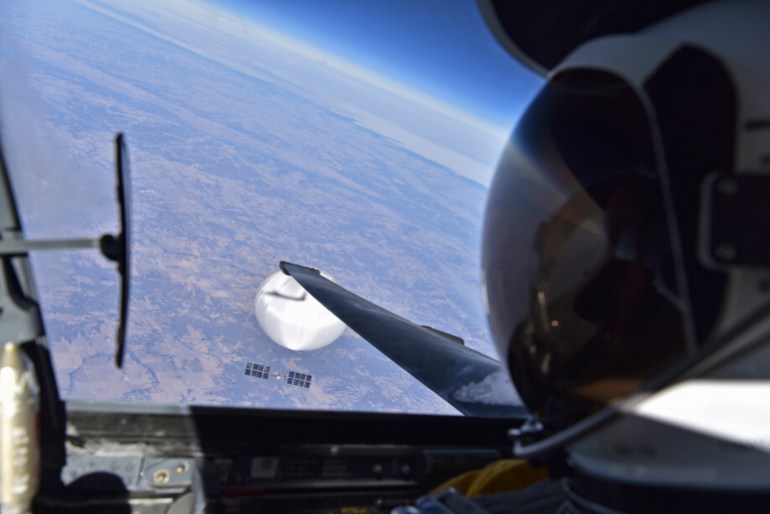Is the stratosphere up for a gold rush?
A new generation of companies wants to use large, uncrewed aircraft to beam down 5G signals and keep an eye on Earth.

When a Chinese balloon was shot down over the United States on February 4, it became a worldwide diplomatic scandal.
The US accused China of using the stratosphere – the area above 7 to 20 km in altitude, depending on the latitude – as a way to spy on the US. China responded with threats of its own and claimed the balloon was civilian and had meteorological purposes.
Keep reading
list of 4 itemsReport reveals over 600 abuse cases in Baltimore Catholic church
‘Brink of nuclear war’: North Korea warning on military drills
Formula 1 in the skies: could flying cars soon be a reality?
For Neal Unitt-Jones, however, thinking about stratospheric objects like the Chinese balloon is just a regular day at the office. “It was not a surprise at all”, he said. “This technology has been around for a while now. It’s just another utility in the stratosphere.”
In recent years, the space around Earth has become increasingly crowded with satellites. Yet, the higher reaches of the Earth’s atmosphere remain surprisingly untouched. A new generation of companies, however, wants to change that. Using large, uncrewed aircraft, they want to beam down 5G signals and keep an eye on Earth.
Unitt-Jones’s firm, the Cambridge-based Stratospheric Platforms, is one such company and is planning to add another aircraft to the stratosphere – a so-called High-Altitude Pseudo Satellite or HAPS.
If the vision of companies like Stratospheric Platforms becomes a reality, it will mean that by the end of the decade, the stratosphere might be filled not just with the occasional stray balloon, but also with uncrewed, powered aircraft – flying above regular air traffic – that can stay there for weeks to even months at a time.
Stratospheric Platforms has so far managed to raise more than $85m in capital from German telecom company Deutsche Telekom and is in a fundraising round hoping to add another $160m to that number. Its idea is to use HAPS to provide telecommunication services from the stratosphere.
Aerospace giant Airbus has also been, for years, building a HAPS and planning to commercially launch its craft next year. Other large investors and aerospace players, such as SoftBank, BAE Systems and Boeing, are all testing or have proposed HAPS designs.
“We’re seeing very interesting opportunities in this market”, said Hussain Bokhari, a senior analyst at the research firm Northern Sky Research, which has conducted studies on the market for HAPS. It concluded in 2020 that by 2029, the market for stratospheric aircraft, which includes HAPS as well as balloons that use high altitudes for services like predicting the weather, would amount to $4bn in cumulative revenues.
It also predicted annual growth in revenues of 13 percent during that period. “It’s going to be exciting to watch how the field develops”, said Bokhari.
Pseudo-satellites
The company that has the most advanced HAPS design is Airbus with its Zephyr. The aircraft has a wing span of 25 metres (82 ft) and is powered by solar energy. During the day, solar panels charge batteries that keep the aircraft flying at night.
In 2022, one of Airbus’s aircraft flew for 64 days straight after which it was lost. The Zephyr is currently going through the certification needed to make its commercial debut, which is scheduled to happen around the end of 2024.
“HAPS are like cell towers in the sky”, said Samer Halawi, CEO of AALTO HAPS, the Airbus spin-off dedicated to commercialising the Zephyr. “Signals emitted from them can directly connect to your smartphone, which you cannot do from a satellite.”
HAPS will mainly be used in ways similar to satellites. They could connect people and households on the ground, particularly in badly-connected areas, or they could do earth observation, gathering information on issues like economic flows or weather patterns. Military and national security applications are also being considered, such as spying or monitoring borders.

HAPS have been around for a long time but so far, most companies have failed at making the technology work in a way that is commercially attractive. This is something Halawi knows very well. “When I first joined this company, someone gave me a picture of a HAPS design from 1945”, he said. “The idea is very old.”
According to Halawi, however, the technology has since changed and is nearing commercial readiness. Aircraft materials have become lighter, solar panels have been introduced and batteries are improving rapidly. “We’re at the beginning of a completely new HAPS industry”, he said.
Whether HAPS will find real-world markets, however, remains to be seen. “HAPS need to show real-world value”, said Bokhari. “The technology still needs to become more concrete and it needs to show how it relates to existing options, like satellites or ground-based infrastructure.”
According to proponents, however, HAPS have what it takes.
“Satellites fly higher, so cover wider areas. But in turn that causes downsides”, said Halawi. “Connections are better from the stratosphere. And we can take more granular images if we’re flying lower. On top of that, we don’t need to launch our HAPS into space, which reduces costs.”
Additionally, HAPS might work side-by-side with space, in some cases acting as a middle layer between satellites and ground connections.
The hard networks
Offering telecommunication services might be one key market for HAPS. For Stratospheric Platforms, its design could serve as the missing link for telecom networks in rural and remote areas where operators are reluctant to build expensive infrastructure for relatively low amounts of customers.
“The easy parts of terrestrial networks have mostly been built by now”, said Unitt-Jones. “The hard parts might, however, never be done.”
Stratospheric Platforms’s HAPS design is still in the concept stage and has not yet flown, unlike the Zephyr. The company hopes its aircraft will fly in the first half of 2025, with a full entry into service in 2026.
The design also diverges from that of the Zephyr. Stratospheric Platforms wants to power its craft with hydrogen, not solar energy. This would mean less flight time but could also allow heavier equipment on the craft. The design would be bigger as well, with a 60-metre (197 ft) wingspan.
Regardless of the design, it remains to be seen whether the technology can actually reach commercial success.
“This field hasn’t had significant amounts of investments yet,” said Bokhari. “There remains an element of insecurity. Investors are doubting whether they should invest in space or in HAPS. Yet, at the same time, companies that are thinking about space are generally also thinking about HAPS. It really could be a booming new field.”
It is still too early to say if, in a few years, hundreds or even thousands of uncrewed planes will fly above us in the stratosphere, beaming down 5G signals. Proponents are at least working hard to make that a reality.
“This is a blue sky opportunity”, said Unitt-Jones. “We’re not using the stratosphere as much as we could be. And it’s inevitable that eventually, someone will.”